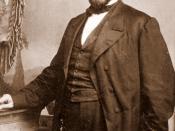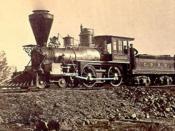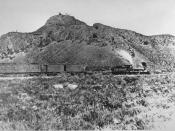The "Railroad Boom"
Starting roughly around 1854 and continuing through the 20th century, North America experienced major changes in transportation. This time could best be described as the "Railroad Boom" due to the enormous amount of time and money spent to unite America's west coast through the use of railroads.
The connection of the Union Pacific and the Central Pacific could very well be described as the highpoint in this early time of the railroad industry. The Central Pacific, lead by Leland Stanford, began construction on the west coast, in Sacramento, California. Simultaneously, the Union Pacific was to begin construction in Omaha, Nebraska. The two railroads were to connect at the California-Nebraska line. After many complications due to Indian troubles and delays, the two railroads met Northwest of Ogden, Utah. The two roads was marked in a celebration with a golden spike, completing the first transcontinental railroad and connecting the Missouri River and Pacific Ocean.
One of the most recognizable names in the railroad industry is that of Leland Stanford. Stanford was not only a successful railroad leader, he was also involved in politics. He served as the Governor of Calfornia from 1861-63 and from 1885 he has served as a US Senator. However, he was most successful in the railroad industry. He was one of the founders of the Central Pacific Railroad, and became its president two years later in 1856. He also later became active in the construction of the Southern Pacific Railroad, serving as its president from 1885-90. After his son's death, he and his wife built Leland Stanford Junior College, now known as Stanford University, as a memorial.
Another well-known name in the railroad industry is that of Collis P. Huntington. Huntington first moved to California during the California Gold Rush. He formed Huntington...


